FRENCH LETTER
Country cooking? It’s complicated…
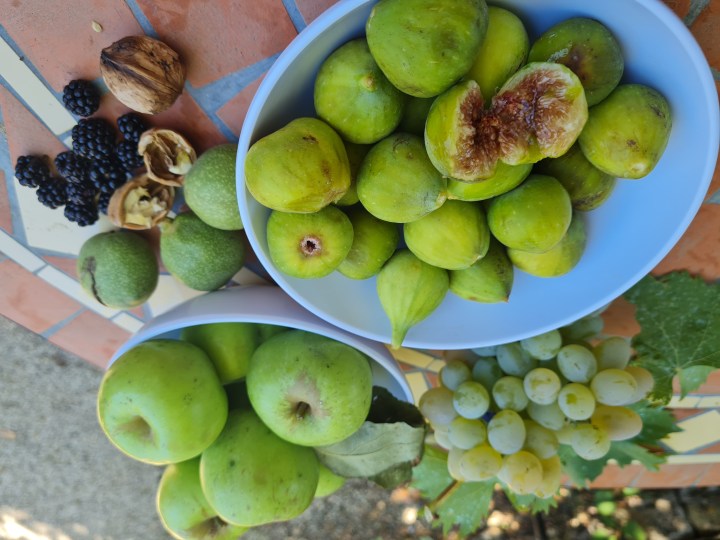
Eating well in an isolated stone cottage, without an oven, can be quite a challenge. Fortunately autumn is a benevolent season in Périgord, with Mother Nature – and friendly neighbours – bearing many gifts.
The past month has been a revelation. After more than two decades in various villages in Provence, I thought I was used to life in the slow lane. But we’d always lived within easy walking or cycling distance of a baker and a grocer, with a weekly market for fresh produce in the village.
Now we’re renting an old summer cottage deep in the heart of Périgord, in the Dordogne department, with the bare minimum of furniture and kitchen equipment. No oven, just a little two-plate stove, and a fridge not much bigger than a cooler box with a freezer compartment smaller than a shoe box. No micro oven, air fryer, mixer, mincer or other electrical stuff, no wok or colander or pancake pan or any fancy cooking utensils.
We have to drive to the closest boulangerie to buy bread, and drive even further for all other groceries. And we can’t buy much of anything anyway because the fridge is too small to store perishables. Eating well – and of course we insist on eating well with limited means and a restricted budget – requires careful planning and abundant imagination. And the ability to improvise if the planning turns out to be insufficient.
In my previous home I also had to plan ahead because all the epiceries or grocery shops in the countryside of Provence close around seven at night, many still close for lunch breaks of three hours (or longer, depending on the mood of the owner) in the middle of the day, and just about every shop is closed from Sunday morning to Tuesday morning. Apart from florists and wine cellars, which have permission to stay open because flowers and wine are regarded as essential goods on a Sunday. (I’ve always admired that special dispensation for flowers, although it does sometimes seem weird that it’s easier to buy flowers than urgently needed medication for colds or headaches on a Sunday.)
But in my previous life I had a big blue kitchen with a Lacanche-type stove featuring no less than three ovens and a selection of gas rings and electrical plates to cook on. This seems like an almost unimaginable luxury from my present vantage point, trying to make a decent omelette on a little stove that has only two settings: too hot or too cold. Previously I also owned two huge fridges, dozens of plates and glasses and enough cooking utensils to host regular feasts with family and friends.
Now that I’m living in “reduced circumstances” – which sounds much more romantic in literature than in reality – it is a daily challenge to feed two people well. And by “well” I don’t mean eating extravagantly, I simply mean making meals from fresh produce, local and in season, no frozen or microwaved fast food, without spending so much time in the kitchen that there’s no time left for writing or reading or other indispensable activities. Did I say “simply”?
Actually there’s nothing simple about a simple life in the countryside.
The revelation, though, is how rewarding the culinary challenge has been. Especially at this time of the year, when the Périgord autumn provides us with free food in fields and woods all around us.
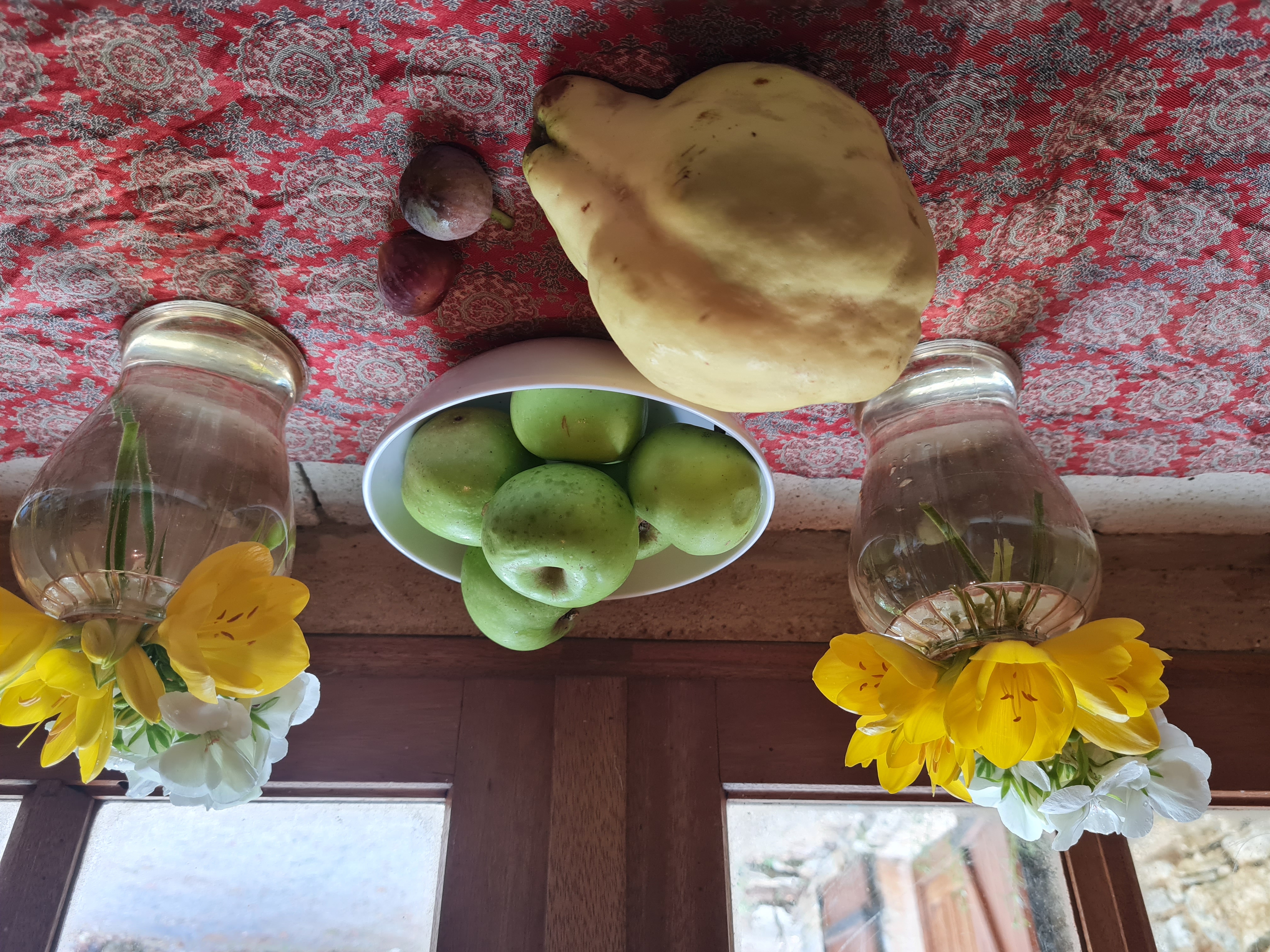
More autumn gifts – apples, quinces, walnuts and flowers. (Photo: Marita van der Vyver)
The last fat blackberries of summer growing next to a river. A lonely apple tree bearing small, juicy, green gifts. Plenty of trees presenting us with shapely little figs, not as irresistibly sweet as the black figs of the beloved tree I planted myself in our previous garden, but I suppose nothing ever equals the taste of fruit you’ve grown yourself, does it? And whatever the Périgord figs might lack in quality, they certainly make up for in quantity.
Because we can’t bake or roast or pulp or freeze food in our primitive kitchen, we have to come up with innovative ways of using Mother Nature’s bounty. So no baked apple pies, alas, and no roasted figs accompanying various meats. No fruit smoothies or semifreddos either. But we found a wealth of ideas on the internet. We don’t have Wi-Fi in the village, but thank heavens we have excellent phone connections for the internet, which I now know is the one indispensable modern convenience if you want to work in an isolated stone cottage. I can get by without an oven or a freezer, a washing machine or a dishwasher or even an iron.
Who needs ironed clothes anyway, as long as you can work and eat well?
We have been using those small apples in salads with beetroot or blue cheese, we have caramelised them on the stove-top to eat with pork chops, or braised them with red cabbage for pork stews. Apples also go well with the pride of Périgord cuisine, duck meat and foie gras.
Unfortunately we can’t forage ducks on our daily walks – but we can buy duck meat and duck liver directly from the farmers around us, which is a lovely consolation prize.
With the figs we’ve made even more sumptuous salads, combining the sweetest ones with slices of warm fried goat’s milk cheese, or mixing honey-fried figs with slivers of smoked ham and walnuts – another free food provided by nature in this region. (If we had an oven we would’ve roasted the figs, but we’ve learned to love fried figs too.) Another yummy idea is coq au vin with the mushrooms replaced by figs – at least until the mushrooms start popping up in the woods later in autumn. We still want to barbecue fig and lamb chunks on skewers. The nights are getting chilly, but we hope to have at least one more braai before winter sets in.
Autumn is also pumpkin time, and although we don’t have our own pumpkin patch, I got some pumpkin flowers from a neighbour’s vegetable garden. I dipped them in a batter made from flour, egg, Parmesan, finely shredded basil leaves and a little water, and quickly fried them for an easy flower-power supper when my partner was away for a weekend.
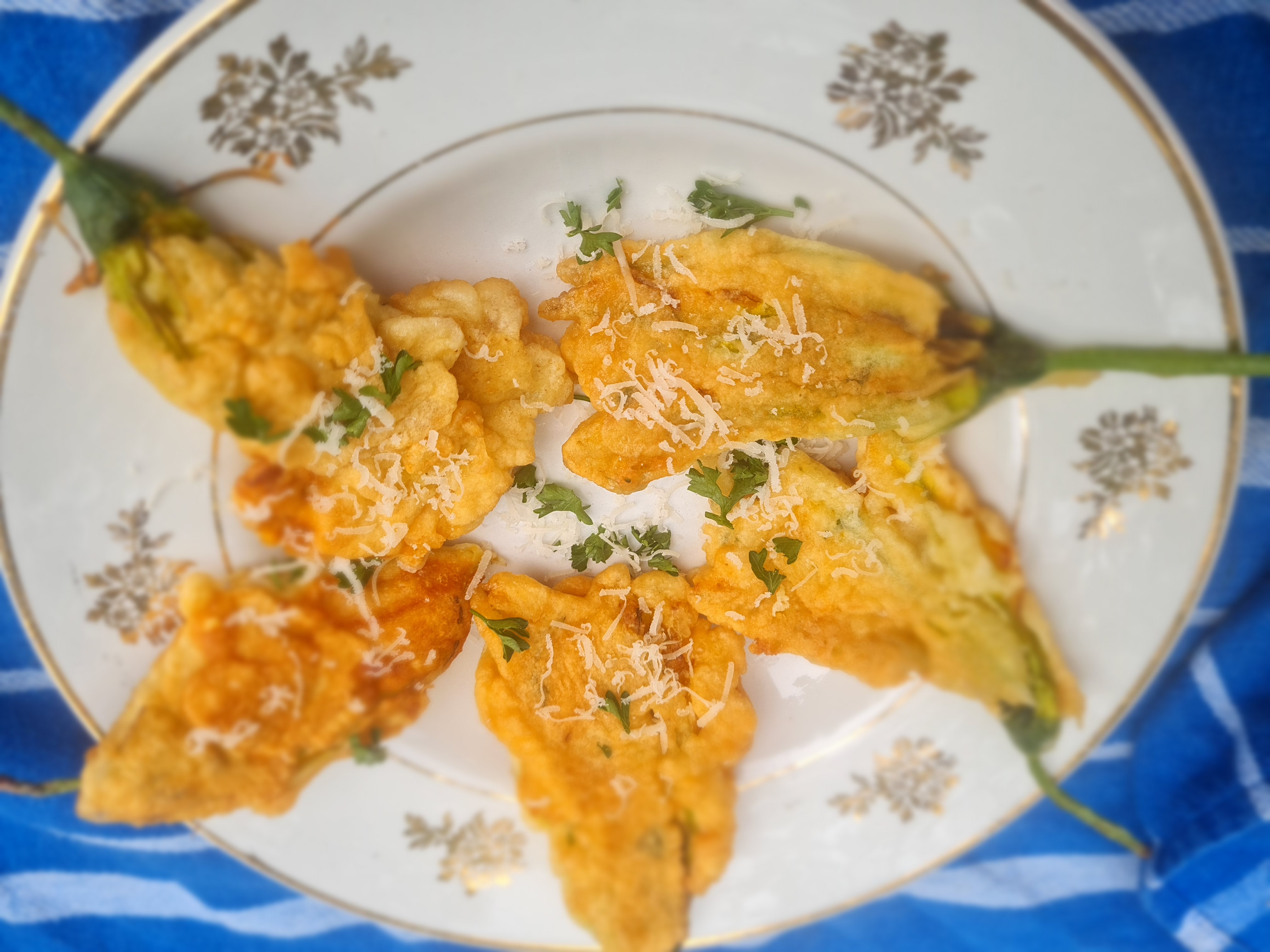
Fried pumpkin flowers. (Photo: Marita van der Vyver)
For free grapes we don’t even have to go outside, we only have to lean out of the bedroom window to pick a bunch hanging from the arbour in front of the cottage. In Provence our house was surrounded by vineyards, but those grapes were grown for making wine, not at all suitable for eating. So for the past month, as the pale green grapes got plumper and sweeter by the day, we enjoyed them straight from the bunch as well as in quite a few meals. Of course we made the ever reliable Waldorf salad, created more than a century ago in New York’s Waldorf-Astoria Hotel, because that gave us the opportunity to use some of our remaining apples too, and walnuts, once again. We cooked grapes in a ginger syrup for dessert and preserved a couple of bunches in the form of an easy green-grape marmalade.
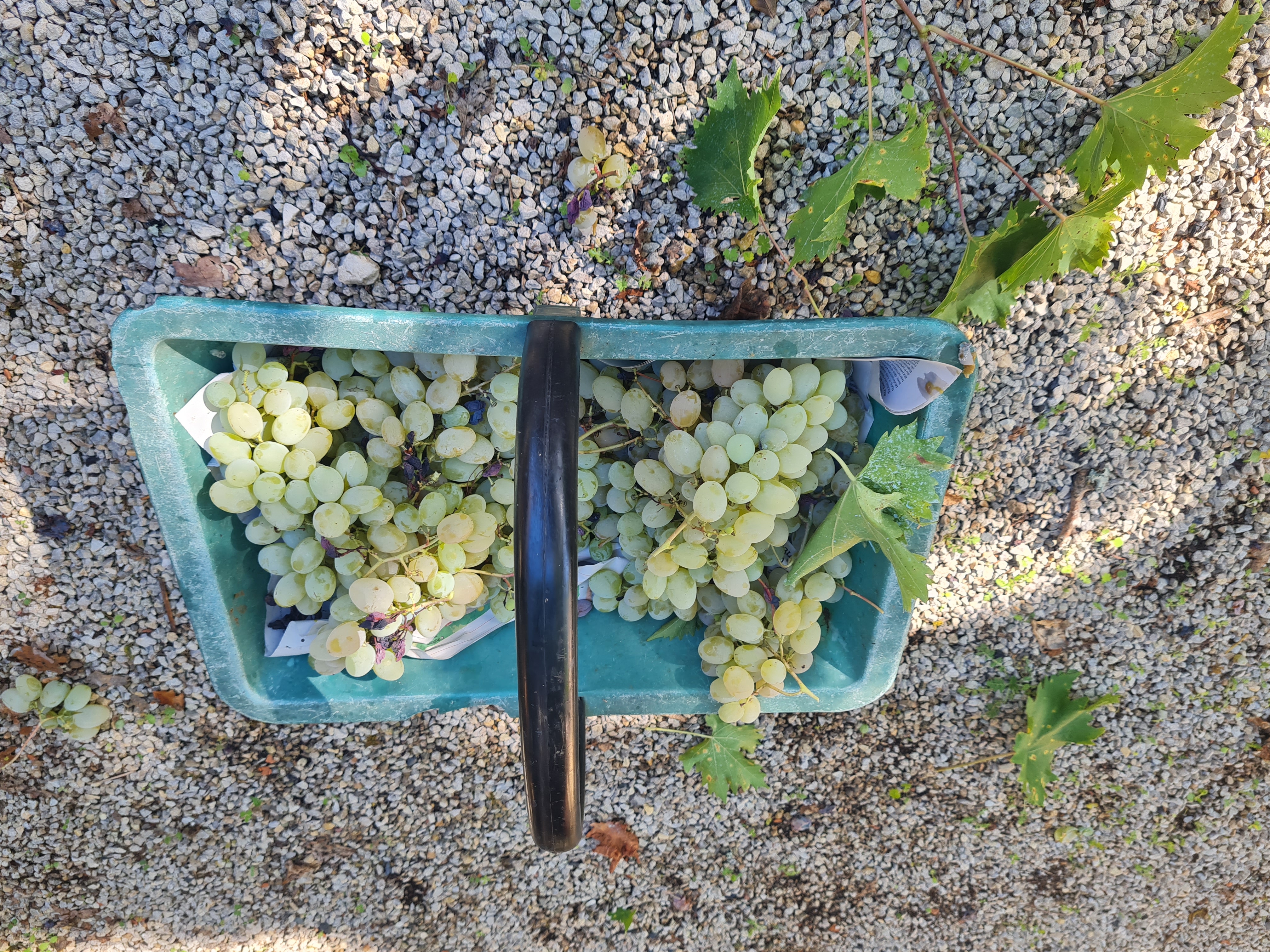
Harvesting our grapes for pineau. (Photo: Marita van der Vyver)
There were still more grapes than we could eat, and we began to look forward to the day our neighbour would come and harvest the remaining bunches for the sweet fortified wine he makes each autumn. He uses the grapes from his own garden and others in the street, compensating the owners with bottles of his homemade pineau. Most of the houses around us are abandoned ruins or deserted holiday homes used only in summer by owners living elsewhere in Europe, so if Monsieur Voisin didn’t harvest the grapes in autumn they would be eaten by insects or birds.
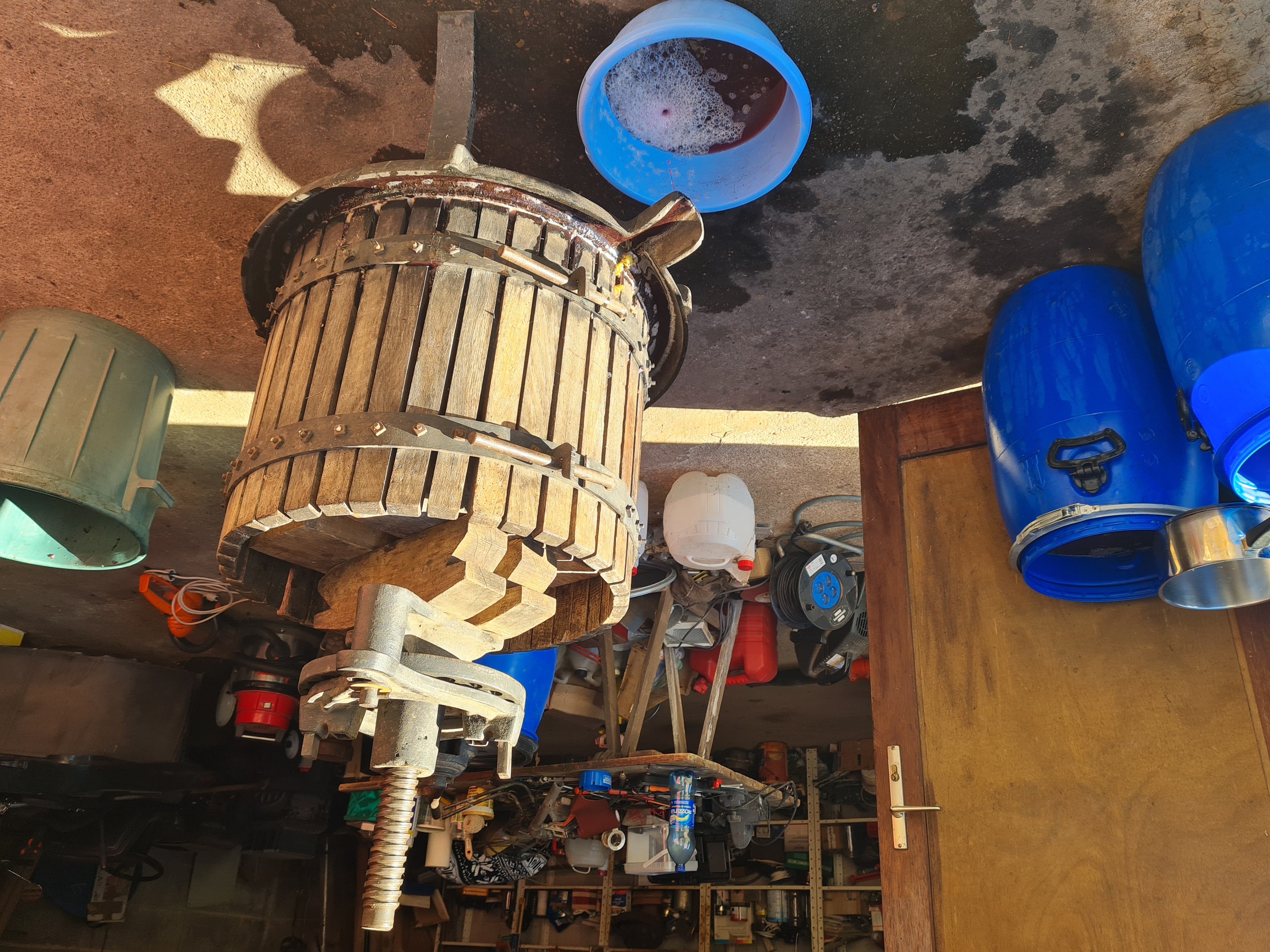
The press and other tools for homemade wine. (Photo: Marita van der Vyver)
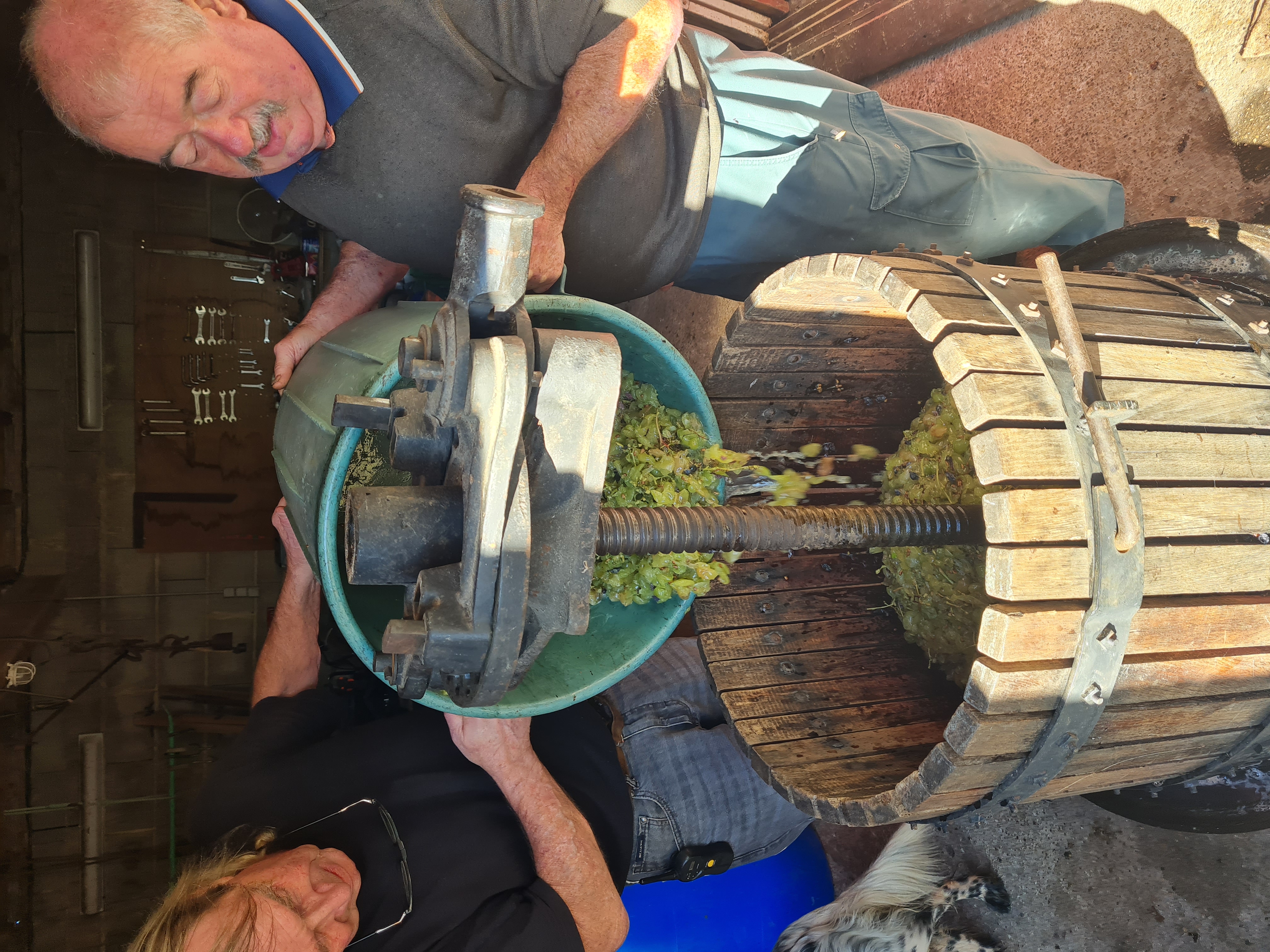
Making pineau in a garage. (Photo: Marita van der Vyver)
This week Monsieur Voisin finally carried his ladder to our arbour, and we could watch him manufacture his fortified wine with the aid of an ancient manual press in another neighbour’s garage. He gave us a bottle of last year’s pineau – it has to age at least a year before you drink it – and it tasted surprisingly good.
I have to add that my standards were probably lowered after trying out the wine that other villagers were making in a barn last week. I passed the barn on my morning walk when the men called me over to come and taste. When I protested that it was a little early in the day for me to start drinking, I still had to work, they insisted on giving me a litre in a plastic bottle. Maybe this was what the French call a cadeau empoisonné (a poisoned gift), because it was truly undrinkable. I certainly wasn’t expecting a grand cru, but I ended up pouring the brew down the kitchen drain.
Still, it’s the gesture that counts, and it was a very friendly gesture from perfect strangers.
What tasted even better than Monsieur Voisin’s pineau was the fresh juice he poured into a bottle straight from the press, before he added the alcohol. (The renowned pineau des Charentes is made with Cognac, but our neighbour uses less expensive alcohol for his garage version.) I might be prejudiced because the grapes from which the juice was pressed had been hanging in front of my bedroom window until two days earlier, but still. No store-bought grape juice had ever tasted as sweet as this amber-hued ambrosia.
The biggest surprise of our Périgord autumn is the abundance of walnuts. We were used to grapes and figs and berries and other wild fruits in Provence, but we’ve never lived in a walnut-producing region. I’m embarrassed to admit that until a few weeks ago I wouldn’t have recognised those bright green balls hanging from the trees even if one fell on my head. I thought walnuts were protected by their hard shells. I didn’t realise that the shell was also protected by a thick green skin which bursts open when the nut gets too big, almost like a jacket splitting at the seams when the wearer becomes too fat.
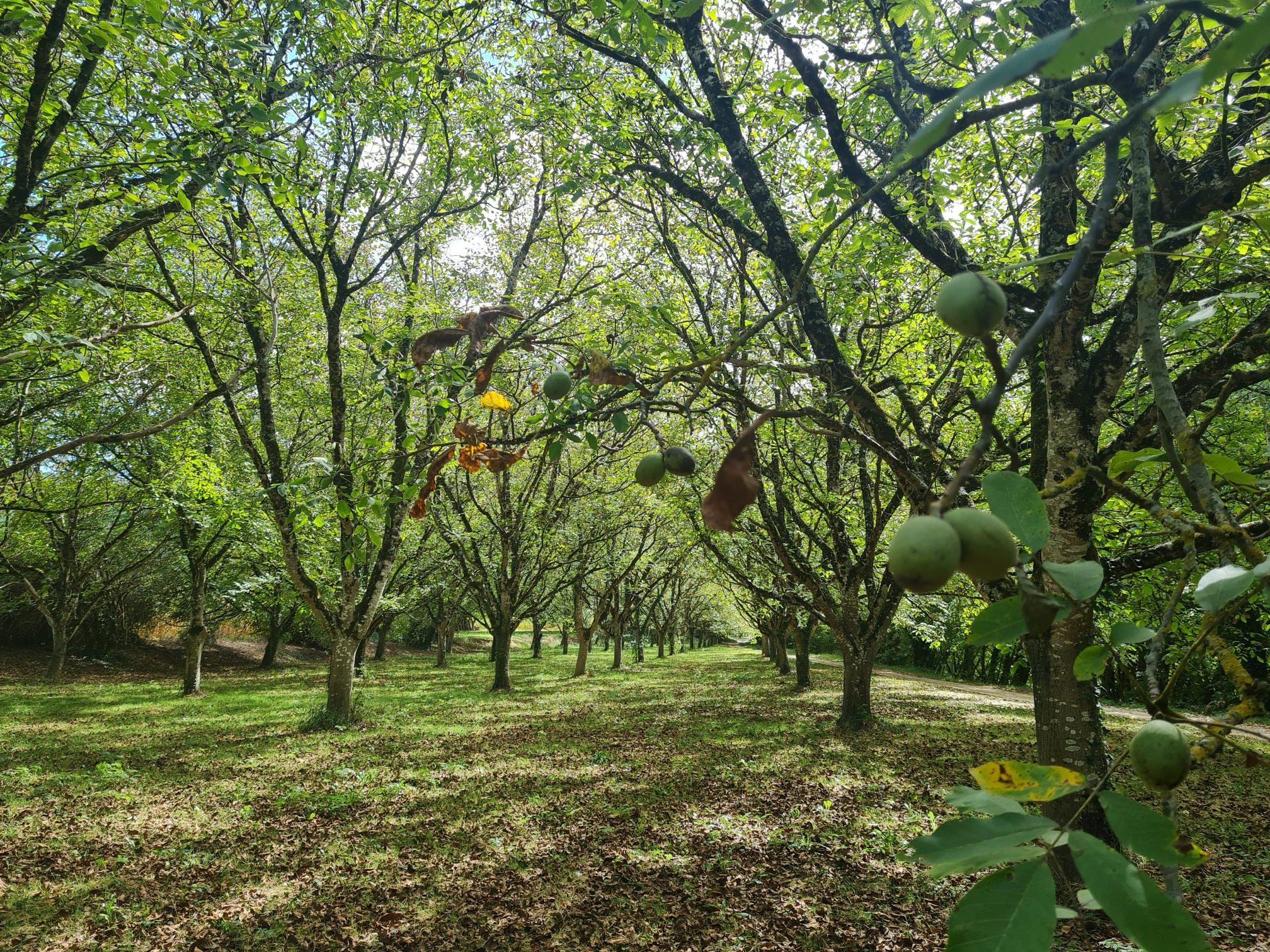
Rows and rows of walnut trees. (Photo: Marita van der Vyver)
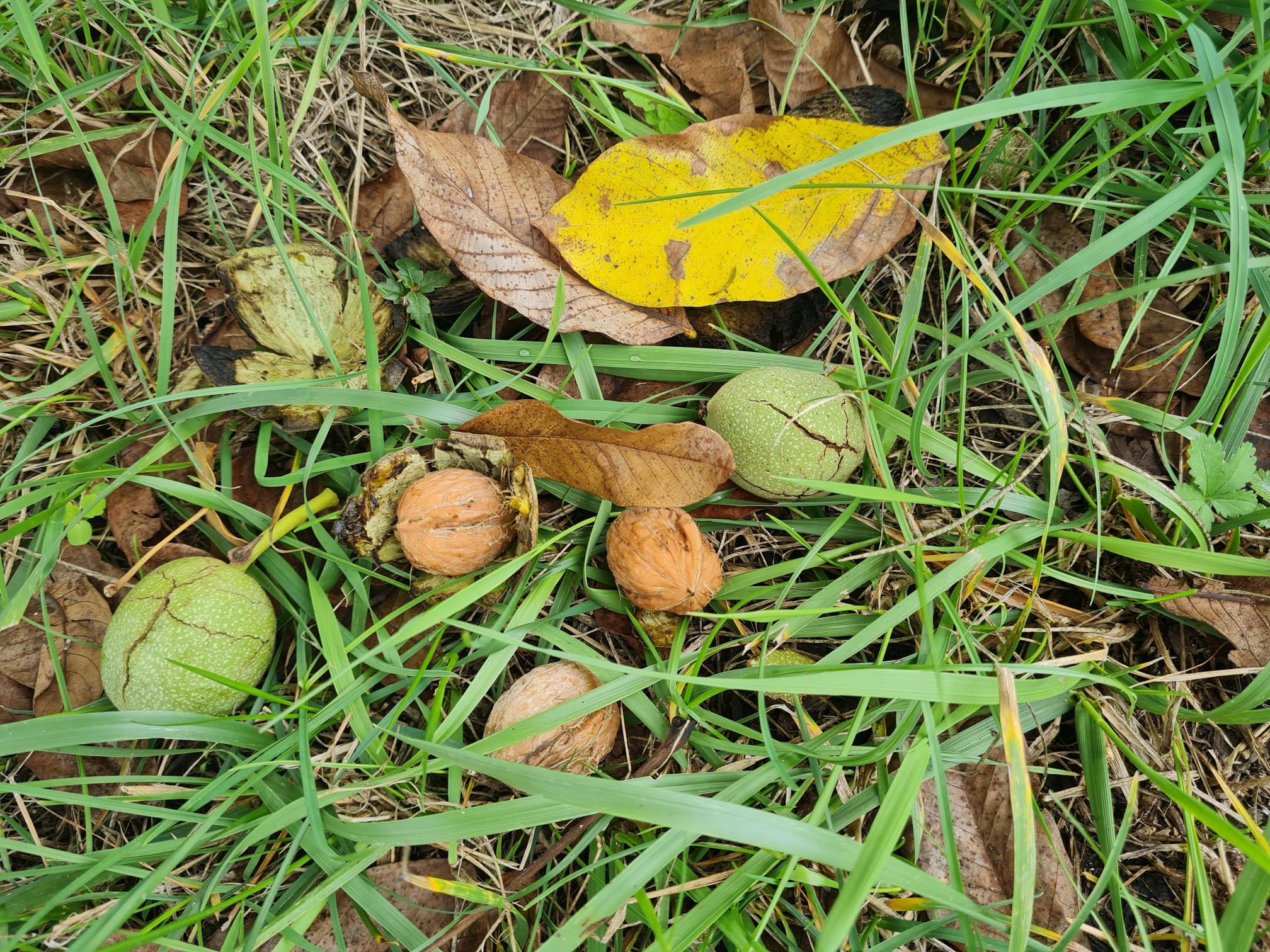
Tripping over walnuts. (Photo: Marita van der Vyver)
By now I’m quite the expert at spotting the wild trees growing next to country roads, spilling their nuts at our feet as we walk past. Yes, we’ve literally been tripping over walnuts. And we don’t have to rack our brains to find ways of using them as soon as possible, or preserve them with time-consuming recipes. The whole point of nuts, as squirrels and other hibernating animals know, is that they can be stored, easily, in their hard shells, for the long winter ahead.
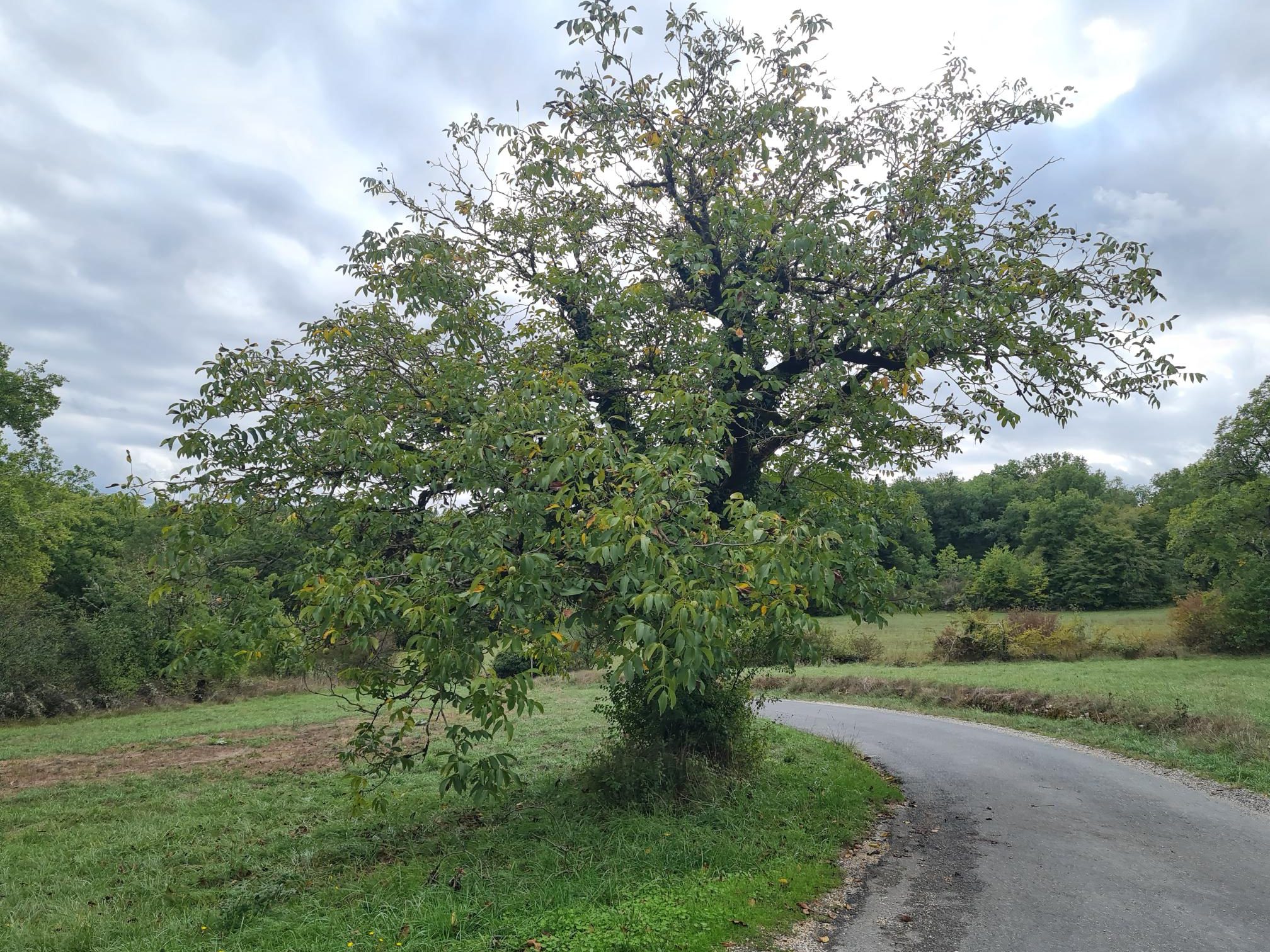
A lonely walnut tree next to a country road. (Photo: Marita van der Vyver)
So we are foraging walnuts as diligently as squirrels for as long as they keep falling from the trees. Who knows, we might even have some left by the end of the year, when we hope to celebrate Christmas in a slightly bigger house – with an oven! – surrounded by our own books and belongings once again. I can already see us next to our Christmas tree, cracking open our walnuts, reminiscing about our glorious autumn of foraging in Périgord. Because everything always looks better when you look back at it. DM/TGIFood
Follow Marita van der Vyver on Instagram @fakingfrench




Comments - Please login in order to comment.